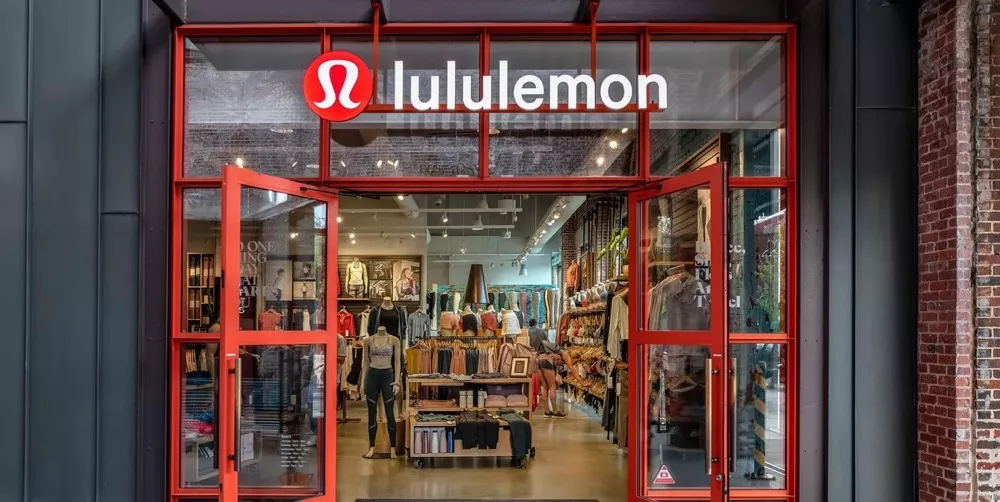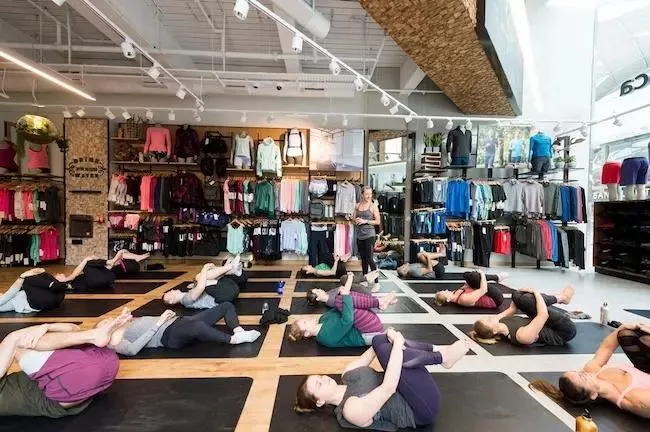In recent years, people's lifestyles have changed as a result of the epidemic. Due to being homebound for a long time, people have put the matter of fitness on the agenda.
If you're visiting the US and you're walking around, you might notice a lot of girls who don't seem to be wearing any pants, but don't panic! They're not wearing fall pants or bottoms, they're probably wearing Lululemon yoga pants, known as "nude pants".
At the opening ceremony of this year's Winter Olympics, the Canadian delegation entered in a beautiful red dress from bottoms, shoes to clothes, and when they saw their outfits, netizens were "planted".

This time, it's not the Canada Goose brand that Chinese consumers are familiar with, but Lululemon, a new and well-known sports brand that started out as a yoga wear brand.
Founded in 1998 by Chip Wilson in Vancouver, Lululemon is a high-end yoga and exercise brand.
In recent years, yoga pants have also become very popular in China. a pair of Lululemon's pants can sell for around RMB 1,000 in China, and in many places, they even outsell Nike and Adidas.
It reportedly took only about 20 years after Lululemon was founded to become one of the top 3 in the global sportswear market, with a market cap of $50 billion on the NASDAQ, surpassing even sports stalwart Adidas.
How did Lululemon grow? And what exactly did it do to reach a market cap of $50 billion?
Brand history
In 1998, founder Chip Wilson was living in the birthplace of a trendy movement. One day, while attending a yoga practice, he noticed that there weren't many sportswear options for women, which led him to smell a huge business opportunity.
So, to address this pain point, Chip Wilson founded Lululemon in Canada in 1998 with a mission to create a sportswear brand for women that would show off their perfect bodies.
When you think of Lululemon, the brand name must be catchy. In fact, the founder initially wanted to name it "Athletically Hip", but since the brand was to be international, the pronunciation had to be as simple and easy to remember as possible, so the name Lululemon was finally decided.
As you can see, the brand name is also crucial for a company or brand that wants to go global.

In 1999, he opened his first store in Vancouver, Canada. By the end of 2021, lululemon had 574 owned stores worldwide. In 2022, Lululemon expects to open 70 new stores, of which about 40 are for international markets.
Inspired by a healthy lifestyle, Lululemon conveys a "hot sweat lifestyle philosophy" to consumers.
Good quality and a wide range of products
Lululemon was founded with a strong emphasis on the technological aspects of clothing materials. The use of light, flattering textile materials for yoga wear is a good solution to the problem of coverage when people are stretching for exercise.
Also, Lululemon's fabric does not reveal flesh tones as people perform different postures in yoga, thus avoiding the embarrassment of "see-through".
Since sportswear has to meet people's movement scenarios, it requires fabrics that are sweat-absorbent, odor-resistant, durable and easy to clean. For this reason, Lululemon uses different fabric technologies to meet the core demands of consumers in multi-sport scenarios.
For example, the Align range of pants is a representative range of NuluTM fabrics that reduce distractions during yoga practice and allow the consumer to stretch without feeling constricted.

For Lululemon, consumers agree that the material is not only comfortable to wear, but also designed to show off a woman's curves. They can be worn as workout wear or for everyday wear, and Lululemon's yoga pants offer privacy without the embarrassing "camel toe".
It is these advantages that make it stand out from the crowd of sports brands.
In recent years, "Athleisure" has become a hot trend in the fashion industry, and Lululemon's products have been designed with comfort and style in mind, making sportswear as accessible as possible to all occasions.
Lululemon entered the market with yoga pants as the entry point, gradually covering more sports and daily scenarios, including yoga, swimming, running, training, business commuting, leisure, etc., meeting consumers' needs for sports and leisure apparel in multiple scenarios.
The quality of products that are as unfussy as possible and the variety of choices offered to consumers, constantly enhancing the functionality and design of the products, will enable the brand to maintain steady growth in the long term and be unbeatable in its category.
Integrated online and offline marketing
Lululemon realized the importance of branding early on in the brand's development by creating a team of KOLs to reinforce the brand's philosophy and thus build a long-lasting relationship with consumers.
The company's brand ambassadors include local yoga teachers, fitness instructors and athletes in the community. Their influence enables Lululemon to find yoga-loving and beauty-conscious consumers faster and with greater precision.
As the Hermes of the yoga world, Lululemon's product quality is naturally nothing to write home about, which has helped it quickly build a good reputation in the community and win the hearts of more consumers.
As of 2021, Lululemon reportedly has 12 global ambassadors and 1,304 store ambassadors. lululemon's ambassadors post product-related videos and graphics on mainstream international social media, further amplifying the brand's social media presence.
As of today, there are 3.511 million posts related to "Lululemon" on Instagram.
Brands' choice of weblebrities also determines the effectiveness of publicity. Only the right choice of weblebrities that match the brand's tone, etc. can help brands expand their influence on social media.
Lululemon also does a great job with BGC (Brand-generated Content), which is content produced by Lululemon global and local brand teams.

Content in branded production content refers to content material other than commercials, with four main categories: product introductions, creative clips, yoga and fitness science, and community stories.
There are many videos of yoga classes on the official Lululemon account on YouTube. These videos make it possible for people who work out at home during the epidemic to find a best reference to learn from.
Not only is Lululemon's clothing of good quality, but the videos of the classes posted on social media are also liked and collected by the general public.
Lululemon also regularly invites store ambassadors and non-ambassador sports and fitness professionals to run, train, yoga and Pilates classes in the community. Large offline events are held frequently to expand the brand's reach.
For example, in April 2021, Lululemon launched a "Hot Sweat No Limits" campaign in 45 stores in 19 cities across China; in the same year, the Summer Fun Challenge was launched in 52 stores in 21 cities across China with over 2,000 participants.
As you can see, the impact of offline marketing can't be overstated.
DTC model close to the consumer
Lululemon sells through directly operated stores, e-commerce channels and other channels, rather than a franchise or chain model.
Adopting a vertical sales model centered on direct stores and e-commerce channels, we are able to reach end consumers directly and closer to them.
It also means that brands can quickly access consumer demand preferences and respond to consumer pain points in a timely manner, which facilitates brand communication and the creation of a full consumer experience.

The benefits of an all-direct model include.
(1) Guides in direct stores can educate customers about the technology embedded in the product through consumer education and increase consumer knowledge of the product.
(2) The direct mode can strictly control the price system of the products, thus maintaining the high-end image of the brand.
Directly operated stores are Lululemon's primary sales channel, with revenues reaching approximately $2.5 billion in 2019, or 63% of total revenues.
In 2020, Lululemon's direct store revenue declined 34% due to the impact of the epidemic and the rise of at-home fitness, while the e-commerce business experienced rapid growth, with its revenue share rising from 29% to 52%, surpassing direct store revenue.
For the fourth fiscal quarter ended January 30, 2022, Lululemon revenue was $2.1 billion, up 23% compared to the same period last year. Same-store sales were up 32 percent, while the DTC (direct-to-consumer) channel was up 16 percent.
Under Lululemon's DTC model, the store community operation was born. The online community can be understood as various Facebook Groups, while the offline community is that each store is an operation space, Sweat Community i.e. Hot Sweat Community.
Some stores not only have branded clothing but also yoga classes, and whether people come to yoga classes or to shop for clothes, this community works invisibly so that consumers are inadvertently seeded to make a purchase.
The Editor's comment
To make a good brand, apart from the development of a marketing strategy, the first thing in the list must be the product itself.
After solving the problem of the product, the promotion mode of online and offline integrated marketing is particularly important. Online internet celebrity marketing can help brands reach their target consumer groups faster and more accurately, making online promotion more effective.
Successful planning of offline marketing can further increase the brand's voice and gain the attention of the public and even the media.
By selling through direct-to-consumer mode and flattening the channel, brands can enhance communication with consumers and improve operational efficiency, and invariably upgrade the image of their stores.